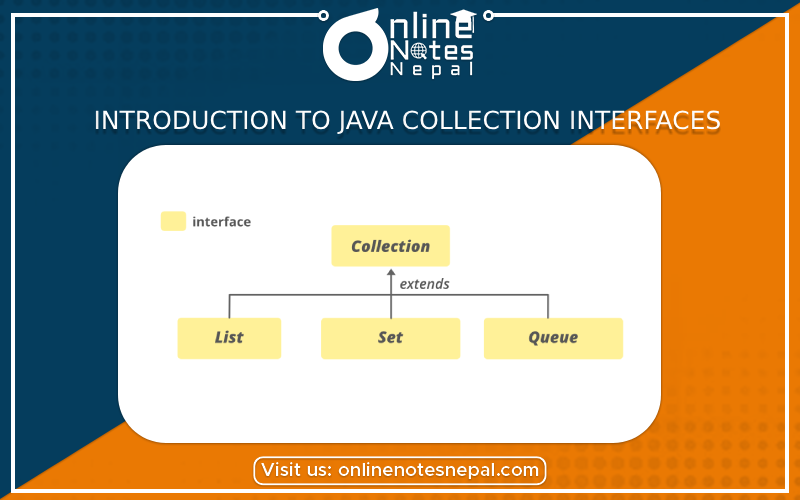Published by: Dikshya
Published date: 14 Jul 2023

Introduction to Java Collection Interface:
The Java Collection Framework provides a set of interfaces and classes to represent and manipulate groups of objects. The Collection interface is at the root of this framework and defines the basic operations and behavior that all collections should have. It provides common methods for adding, removing, and querying elements in a collection.
List Interface:
The List interface extends the Collection interface and represents an ordered collection of elements. It allows duplicate elements and provides methods to access elements by their index. The two most commonly used implementations of the List interface are ArrayList and LinkedList.
Set Interface:
The Set interface extends the Collection interface and represents a collection of unique elements. It does not allow duplicate elements and provides methods for adding, removing, and checking the presence of elements. Some common implementations of the Set interface are HashSet and TreeSet.
Map Interface:
The Map interface represents a mapping between keys and values. Each key-value pair in a Map is called an entry. The Map interface does not extend the Collection interface because it deals with pairs of objects rather than individual objects. The most widely used implementations of the Map interface are HashMap and TreeMap.
ArrayList:
ArrayList is an implementation of the List interface that uses a dynamically resizing array to store elements. It provides fast access to elements by their index, but slower performance for adding and removing elements at arbitrary positions.
LinkedList:
LinkedList is another implementation of the List interface that uses a doubly-linked list to store elements. It provides efficient insertion and removal operations at both ends of the list, but slower access to elements by their index.
HashSet:
HashSet is an implementation of the Set interface that uses a hash table to store elements. It provides constant-time performance for the basic operations like adding, removing, and checking the presence of elements. However, it does not guarantee the order of elements.
HashMap:
HashMap is an implementation of the Map interface that uses a hash table to store key-value pairs. It provides constant-time performance for the basic operations like adding, removing, and retrieving entries. It also does not guarantee the order of entries.
Iterators:
Iterators are objects that allow us to iterate over the elements in a collection. They provide methods like hasNext() to check if there are more elements, and next() to retrieve the next element in the iteration. Iterators are commonly used in combination with the enhanced for loop to traverse collections.
String Handling:
In Java, the String class is used to represent a sequence of characters. It provides various methods to manipulate and process strings.
Some commonly used String methods are:
equals(): Compares two strings for equality.
substring(): Extracts a substring from a given string.
replace(): Replaces occurrences of a specified character or substring.
indexOf(): Finds the index of the first occurrence of a specified character or substring.
lastIndexOf(): Finds the index of the last occurrence of a specified character or substring.
trim(): Removes leading and trailing whitespace from a string.
toUpperCase(): Converts a string to uppercase.
toLowerCase(): Converts a string to lowercase.
String Concatenation:
String concatenation is the process of combining two or more strings into a single string. In Java, you can concatenate strings using the + operator or the concat() method of the String class.
String Buffer and String Builder:
StringBuffer and StringBuilder are classes that provide mutable sequences of characters. They are used when frequent modifications to strings are required. StringBuffer is thread-safe but slower, while StringBuilder is not thread-safe but faster.
Calendar and SimpleDateFormat:
The Calendar class provides methods for working with dates and times in Java. It allows you to manipulate dates, extract components like year, month, day, etc., and perform various date arithmetic operations.
SimpleDateFormat is a class that provides methods to format and parse dates in a specific pattern. It allows you to convert dates to strings and vice versa according to a given format.
Formatting Strings, Numbers, Date, and Time:
The Java platform provides the DecimalFormat class for formatting numbers, the MessageFormat class for formatting strings, and the SimpleDateFormat class for formatting dates and times. These classes allow you to define custom patterns and format values accordingly.
Random class:
The Random class in Java is used to generate random numbers. It provides methods to generate random integers, doubles, floats, booleans, and bytes. By default, it uses the current time as the seed value for generating rand
om numbers, but you can also provide a specific seed value if desired.